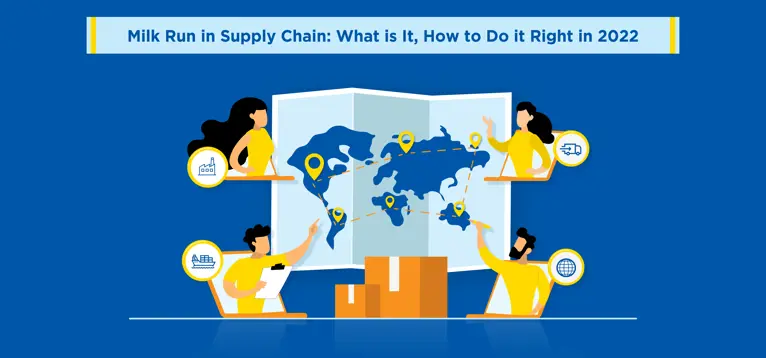Did you know "milk run" has another meaning beyond the last-minute grocery run that you had to do because your housemate left an empty milk carton in the fridge again? It turns out that the logistics pros do not actually mean that kind of run when they use this jargon while talking about supply chain management.
The term has been around for centuries now and is a fundamental part of streamlining the supply chains all over the world. It is a type of delivery technique that optimises logistics through multi-pick, multi-drop, or round-trip operations. It has gained even more popularity with the eCommerce sales expected to cross $5,592 billion in 2022 which warrants a high volume of order fulfilment.
Read on if this term has piqued your interest and you're eager to learn how it makes a difference to your supply chain and logistics. You will find detailed insights on how this delivery technique can transform your eCommerce order fulfilment strategy.
Origin of the Term “Milk Run”
When you think of milk run, it definitely does not reflect anything related to logistics and packaging. Its definition is pretty basic. The term "milk run" refers to the process of delivering milk. Milkmen would travel a set route, bringing milk to customers' houses and collecting empty bottles.
Moreover, in years-gone-by, the trains that used to collect fresh cans of milk by stopping at multiple farms were also known as Milk runs. Also, the WWII pilots referred to the low-risk missions as "milk runs".
A route with multiple stops can also be referred to as a milk-run route. A milk run, for example, is a transportation route that makes multiple stops, generally in small communities.
That’s how the term “milk run'' came to be a common lingo in the industrial arena. Let's explore the concept and understand how it becomes important in the current logistics and packaging business.
What is a Milk Run in Logistics?
Milk run, in the logistics industry, can be defined as the operation of procuring inbound deliveries to warehouses or micro-fulfilment centres. The entire process warrants the involvement of supply chains, be it internal or external. A milk-run is a distribution technique for various loads from a central storage area to various parts of your business.
Internally, it is a type of transportation system that transports supplies from a central location to various assembly regions within your company. The milk run technique also enables just-in-time delivery while minimising waste and material degradation.
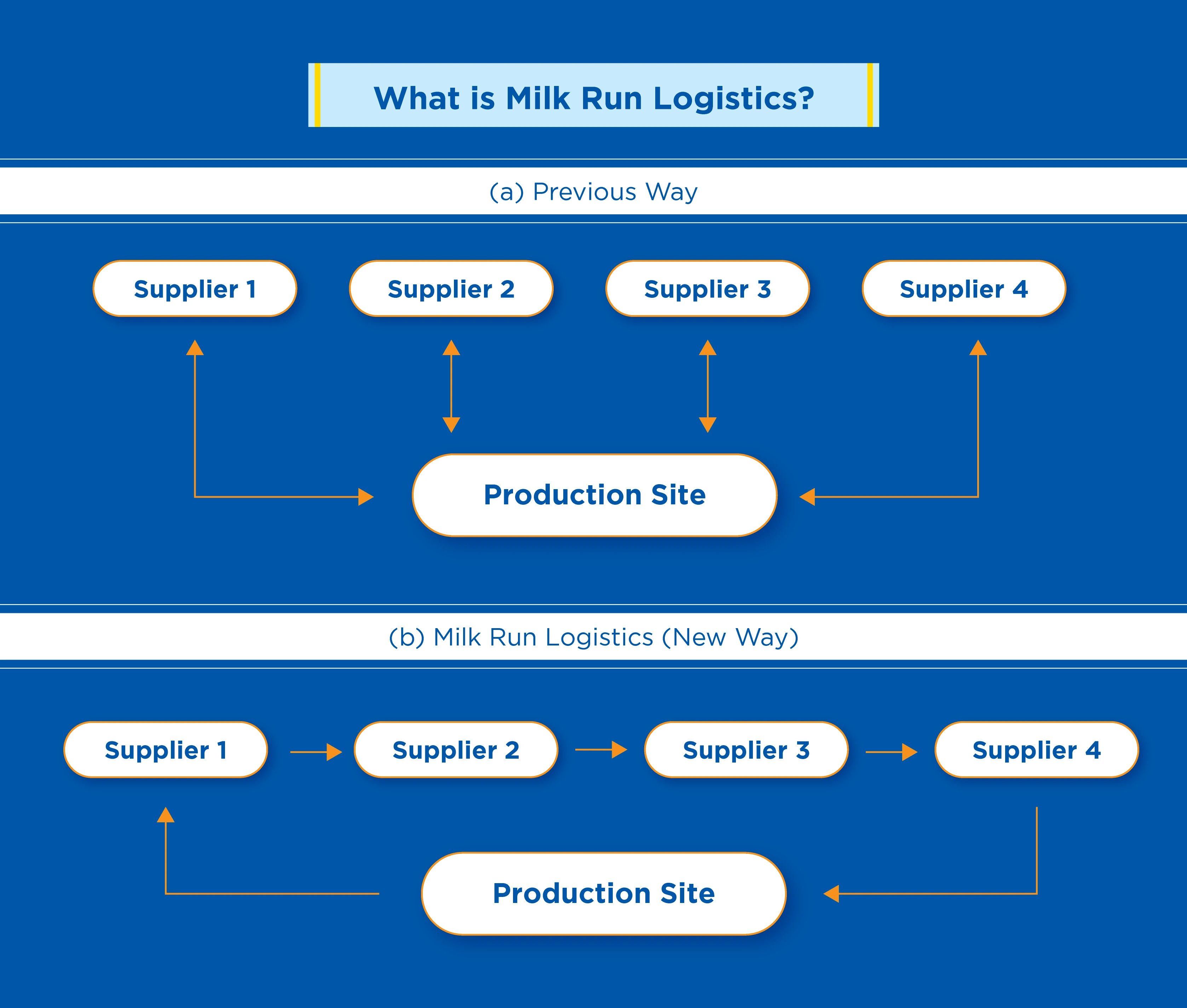
Advantages of the Milk Run Method
The milk runs necessitate extensive planning and cooperation ahead of time. The flow of goods, on the other hand, becomes easier and more dependable by standardising the timing, sequence, and quantity of items to be delivered. This also lays the groundwork for continuous improvement in material movement.
Let us look at the benefits of implementing the milk run method in your logistics.
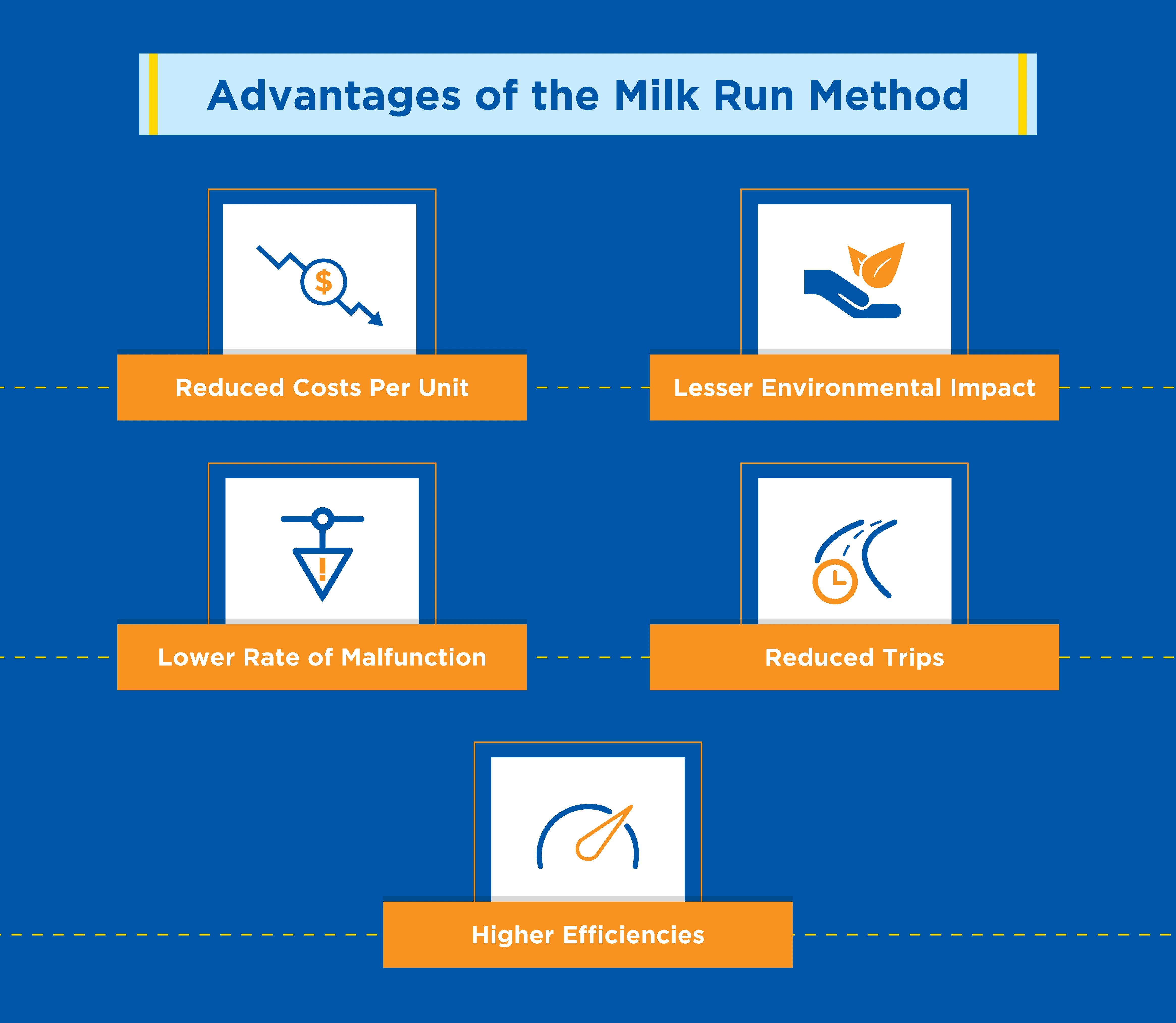
Reduced Costs Per Unit
Manufacturers can control their production by arranging the milk run to deliver only the required amount of items. Producing an adequate amount of finished goods reduces the risk of overproduction, preventing a surplus and saving money on inventory and storage.
A milk run delivery is an example of a Just-In-Time (JIT) logistics system. In this framework, customers bring empty containers to suppliers in return for the resources they require. Rather than supplying a predefined fixed amount of materials, providers can know exactly how much their customers require. Manufacturers who use milk run deliveries frequently lack large-capacity inventory facilities. Oversupply in milk run deliveries is reduced to a minimum in this manner.
Lesser Environmental Impact
Transportation accounts for a significant portion of greenhouse gas emissions. Without any active intervention or change in strategy, the carbon dioxide emission from delivery traffic will increase by 6 million tons in the largest 100 cities of the world.
Not only are milk run deliveries more cost-effective, but they are also a more environmentally responsible logistic choice. When different suppliers send resources through different vehicles, the number of miles travelled increases. With fewer delivery trips through the milk run, carbon emissions and petroleum use are reduced.
Lower Rate of Malfunction
Stock materials do not pile up in your warehouse if you make frequent procurement and delivery excursions to suppliers. This not only improves inventory management but also ensures that the materials you receive are brand new and less prone to malfunction or have flaws. Furthermore, a quality check is made easier because a large batch can be tough to validate, but milk run delivery breaks it down into smaller clusters.
Reduced Trips
You may organise and condense the utilisation of vehicles and the labour needed to discharge supplies by having a regular delivery schedule. You can, for example, organise the purchase of all the heavy items you require on a specific weekday.
This allows you to plan and prepare everything ahead of time now that you are aware of this information. As a result, instead of keeping your discharge crew and equipment on standby 24 hours a day, they may devote their time and energy to more profitable business tasks.
Milk run deliveries necessitate detailed planning. Everything should go well, from delivery routes to scheduling. The courses are the quickest, and each supplier has adequate time to complete the transaction which ensures express courier services. Because milk run deliveries are so efficient, you can get a lot more done in a day or cycle.
Higher Efficiencies
Instead of making multiple visits to different vendors to obtain goods, milk run delivery makes a single trip to all of them, saving time and resources. To fit a large number of commodities onto a single transport vehicle, the vehicle must be used to its greatest potential.
As previously stated, the milk run deliveries allow vendors to quickly estimate the number of products to be delivered. Furthermore, manually arranging orders and haggling costs can be laborious. That is why, with milk run delivery, the supplier and the manufacturer agree on a standard price per piece for smoother interactions.
Challenges of the Milk Run Method
The milk run delivery technique, no matter how useful, needs a lot of meticulous planning. You simply cannot work things out on the go here.
Here are a few challenges you might come across when incorporating the milk runs in supply chain.
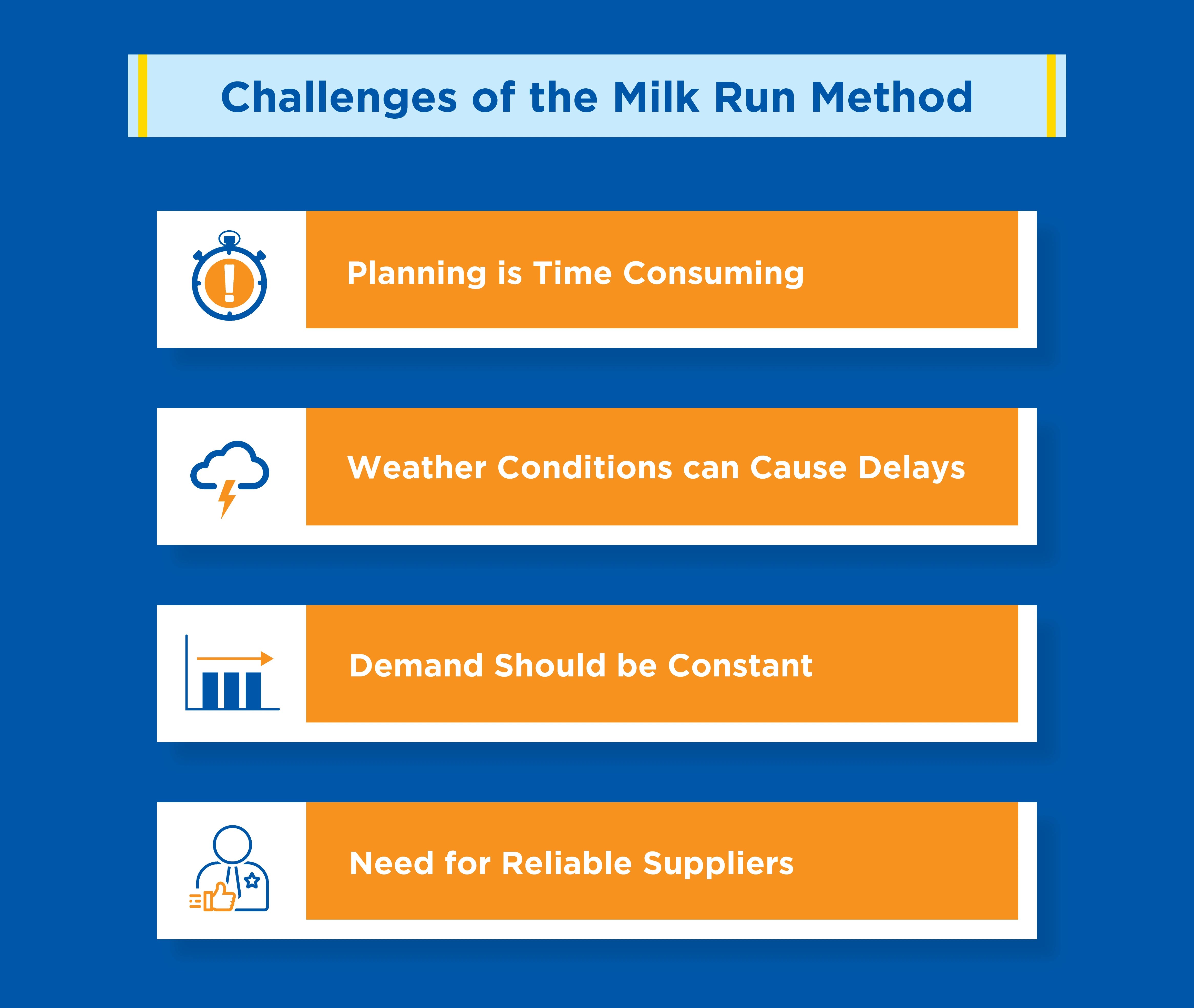
Planning is Time Consuming
Milk runs must be standardised and routed in a specific manner. Customers may believe that a supplier can handle many daily pickups, but this is not always the case. A solid schedule is essential for both predictability and cost reduction.
You need to account for factors like the delivery time frame, different transport volumes, driving times, and so on. Also, create a detailed plan before every step. The effort needed while structuring the milk runs in supply chain makes for an efficient system though.
You'll need to agree on cost-sharing and other details of the cooperative distribution arrangement if the route comprises products from different companies. By pooling operational expenses and resources, this delivery strategy can save time and money for everyone once the organisation has resolved these challenges.
Weather Conditions can Cause Delays
While you can plan all you want, sometimes there are inevitable delays in the delivery. The milk run can work out without any hurdles only if the weather conditions remain ideal at all times, which is rarely the case. The staff driving such delivery trucks is usually professionally trained to overcome any minor setback due to harsh weather conditions.
When transportation conditions are unpredictable along the trip, the milk runs may not be the best option. This could be due to a variety of factors, including weather, bridge closures, seasonal or event-related traffic spikes, and so on. This can be aided by careful route planning, including alternate routes, and detailed awareness of how conditions change. Rushing route planning is a common error that leads to larger inventory buffers or outages.
It becomes near impossible to complete the deliveries on days when the climate is not suitable, i.e. during heat waves, heavy downpours, or extreme winters. This can cause delays in the delivery and the milk run logistics team needs to have a contingency plan ready for such scenarios.
Demand Should be Constant
The demand for the goods obtained by the milk run delivery method may present another challenge for you. As the process accounts for the delivery of multiple items, it so happens that there isn’t a constant demand for each and every item. This leads to problems arranging for the storage of the excess raw material and bearing the unnecessary shipping cost of the materials as well as the delivery.
Need for Reliable Suppliers
The suppliers play an important role in the milk run delivery, like every other supply chain model. You need to partner with reliable suppliers who can fulfil their part during every milk run. This is a crucial aspect and is often more challenging while adopting the milk run model.
This reiterates the fact that it requires a lot of planning to create an efficient route. And if any of the suppliers cannot complete their role, you will have to re-plan the route. Fitting a new temporary supplier on your route may lead to a loss of time and other resources.
How does Milk Run Delivery Work?
Now that you are well aware of the milk run definition, its advantages as well as the challenges that come along with the method, perhaps it is time to understand its mechanism.
In most cases, the steps in a milk-run route can be simplified to:
- Planning an optimised route
- Travelling along with the appropriate vehicle
- Picking or dropping the goods at their destination
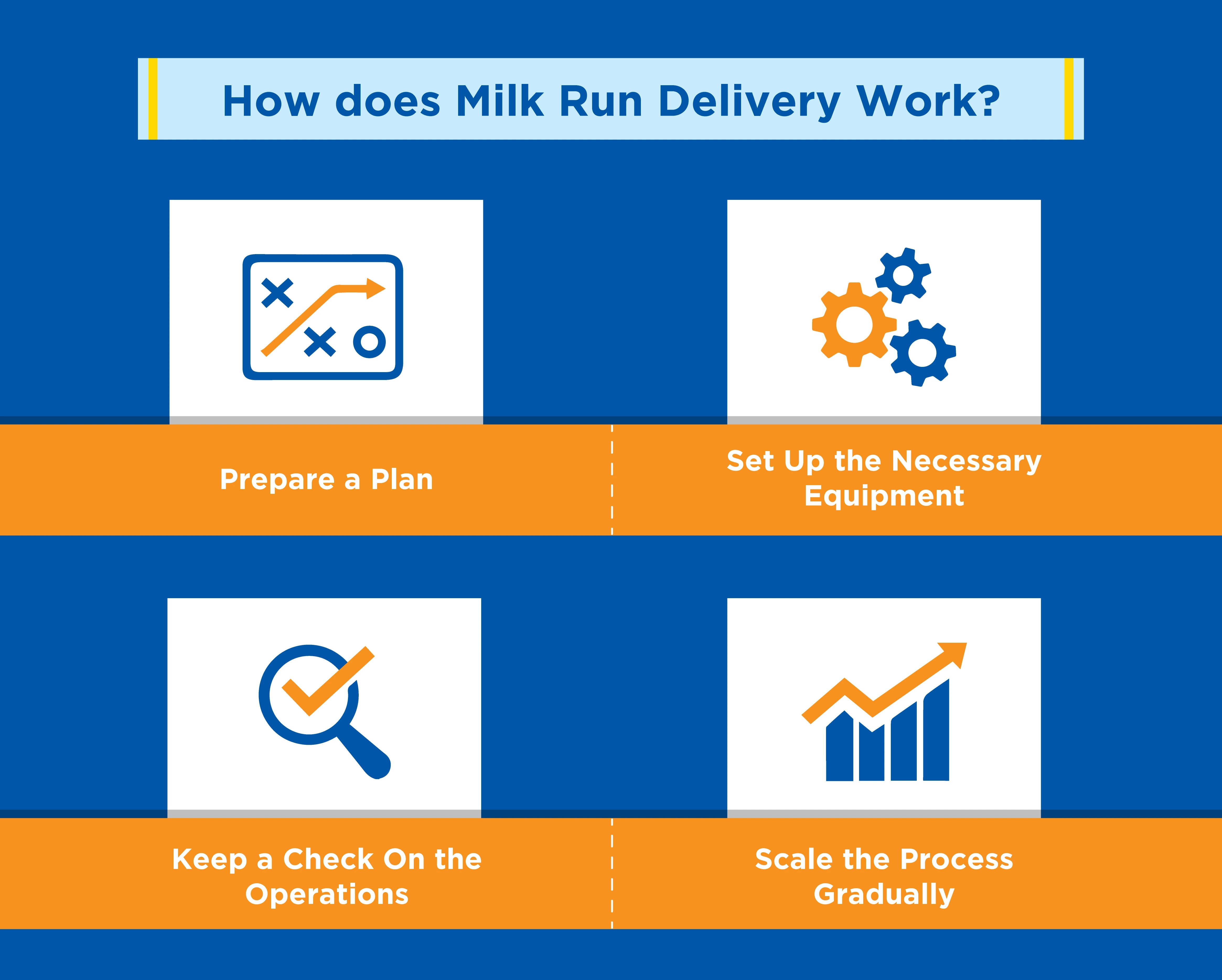
Prepare a Plan
While the premise is straightforward, establishing a milk run system for sophisticated industrial commodities requires careful consideration. The route may include products from many companies, necessitating agreements on scheduling, frequency, container standards, inventory levels, and how to share costs and savings gained through pooling resources in a cooperative distribution approach. The first stage is to develop an understanding of these rules and values.
You can set up a milk run system, however, it calls for the creation of a timetable on an informational level. Such planning serves as the foundation for thorough repeatable work. You will need to map the flow of the materials and information between suppliers and customers, as well as the identify the primary suppliers, acting hubs, or consolidation centres.
Set Up the Necessary Equipment
On a physical level, modifications to containers for material presentation and even transportation equipment, such as dedicated side-loading trucks, are frequently required for smoother commodities transfer. A basic understanding of how to use supermarkets or similar storage facilities is required.
Keep a Check On the Operations
It's critical to observe and time each step of the process at the task or method level, finding common and distinctive things to do at each stop. Although the timetable is the macro-level standard work for commodities transportation, drivers and operators require stop-level standard work as well. In addition to loading and unloading, information verification duties such as the part number and quantity verification, a rapid quality check, and flagging any faults or discrepancies are frequently performed.
Scale the Process Gradually
In order to reap the benefits of this system, it's critical to have a general concept of the commodities, suppliers, and the number of milk run routes that will be required. However, depending on volume, distance, and the supply chain's maturity and stability, it's common to start with two or even one milk run cycle, delivering every four to eight hours. This enables us to move from theory to practice, ironing out the wrinkles before making a more substantial commitment.
To save money, it's tempting to add just one additional supplier or one that's just outside the path. However, if we are not careful, this might become a slippery slope, disturbing routine work, generating delays, backorders, and so on. These cases might be able to be integrated into milk run if they're delivered to one of the suppliers or a third-party logistics location along the route. It's preferable not to be greedy and instead to start small and gradually scale up.
Examples of Milk Run
1. The Wheat Mill
Wheat is supplied to a flour mill by a number of different growers in one area. Every day, each farm may send a delivery vehicle loaded with grain to the mill. This is a fairly typical supply chain process. However, in milk run logistics, a vehicle would transport the milk from the mill to the fields. The vehicle picks up wheat from a different grower at each stop along the trip. This is a more effective approach to collect grain if each farmer only has a portion load to distribute.
2. The Bread Factory
Assume there are 20 separate bread vendors who deliver bread to a central location to suit consumer demands and collect leftover bread from the previous day. It can be done in two ways:
- The suppliers send their own delivery vehicles to the demand centre, where they provide fresh bread and pick up the leftovers.
- There is a single vehicle that departs from the central location and visits each supplier one by one, collecting fresh bread and returning the leftovers to the appropriate supplier. It is also possible to make multiple trips.
The second method is milk run.
An Ideal Milk Run Process
- Volume calculation: The company's supplier procurement planning process starts with a volume calculation based on the next period's production plan. This includes a breakdown of required parts and quantities, as well as the identification of potential suppliers.
- Route planning: Then, utilising information about supplier locations and collection volume at each supplier site, the master milk run pickup route is constructed. Planners start with the previous month's master route design and make modest modifications to it as volumes fluctuate.
- Negotiations with suppliers: Following that, the corporation tells its suppliers of the volumes and pickup schedule, and each supplier engages in negotiations.
- Revise the route: If a change to the master route is required after the negotiation, it is made to complete the master route for the period.
- Assign duties to delivery trucks: The master route is then used to arrange to receive dock activities after it is done. This is vital to reduce congestion and ensure that the facility is used efficiently and uniformly.
Who Should Use Milk Run in Logistics
The milk run delivery technique can be used by industries that involve sourcing raw materials for manufacturing or operating an online eCommerce store that needs to deliver its products at multiple locations. Although it originated in the dairy industry, it is now widely used in the automotive, aviation, naval, and technology industries.
Should You Use Milk Run for Your eCommerce Business?
Milk runs are definitely a great choice for eCommerce businesses. This will help them optimise the logistics cost for delivery. Generally, most e-stores hire logistics service providers to get the job done.
This incurs a fixed cost to the eCommerce business. Using the milk run logistics can help such businesses translate that fixed cost into a marginal amount and make their supply chain even more efficient.
How to Implement Milk Run Logistics while Using a 3PL
The design and implementation of milk run routes, as well as the scheduling of the intervals, are the most difficult aspects of the first setup. This is because it is the most important aspect in determining the method's efficiency. Therefore, collaborating with a 3PL makes it easier for an eCommerce company.
You can execute the milk run through a 3PL by curating a list of suppliers and asking for their suggestions on how to best optimise the delivery route. The route's length and distance from the storage location to the various delivery points all have an impact on the route's effectiveness and efficiency. They have expertise in such matters and will be able to provide the resources to complete the milk run effortlessly. This will help you get it right through them as they perform a lot of testing, experimentation, and time goes into the process.
Also, consider how much demand your delivery points will generate and how frequently they will need to be re-supplied. Because a production schedule is often unpredictable and variable, this can be challenging to manage and implement. As a result, these elements, as well as the impact of real-time events, must be considered in the final milk run design.
A Checklist for eCommerce Business to Use Milk Run in 2022
Because of the rapid rise of eCommerce and hyperlocal delivery platforms, last-mile delivery is one of the hottest areas for entrepreneurs and venture capitalists, yet most newcomers are failing to break even in this low-margin market. You can use the following best practices to incorporate milk run to keep up with inventory management and logistics in 2022.
- Locate the delivery points for the run well in advance
- Etch out a route for the delivery truck so that it can cover all the stops in one go
- Load the delivery truck efficiently so that it can hold a maximum capacity
- Add stops at micro-fulfilment centres to reload the vehicle and increase efficiency
- Use track and trace technologies accurate location of the milk running vehicles
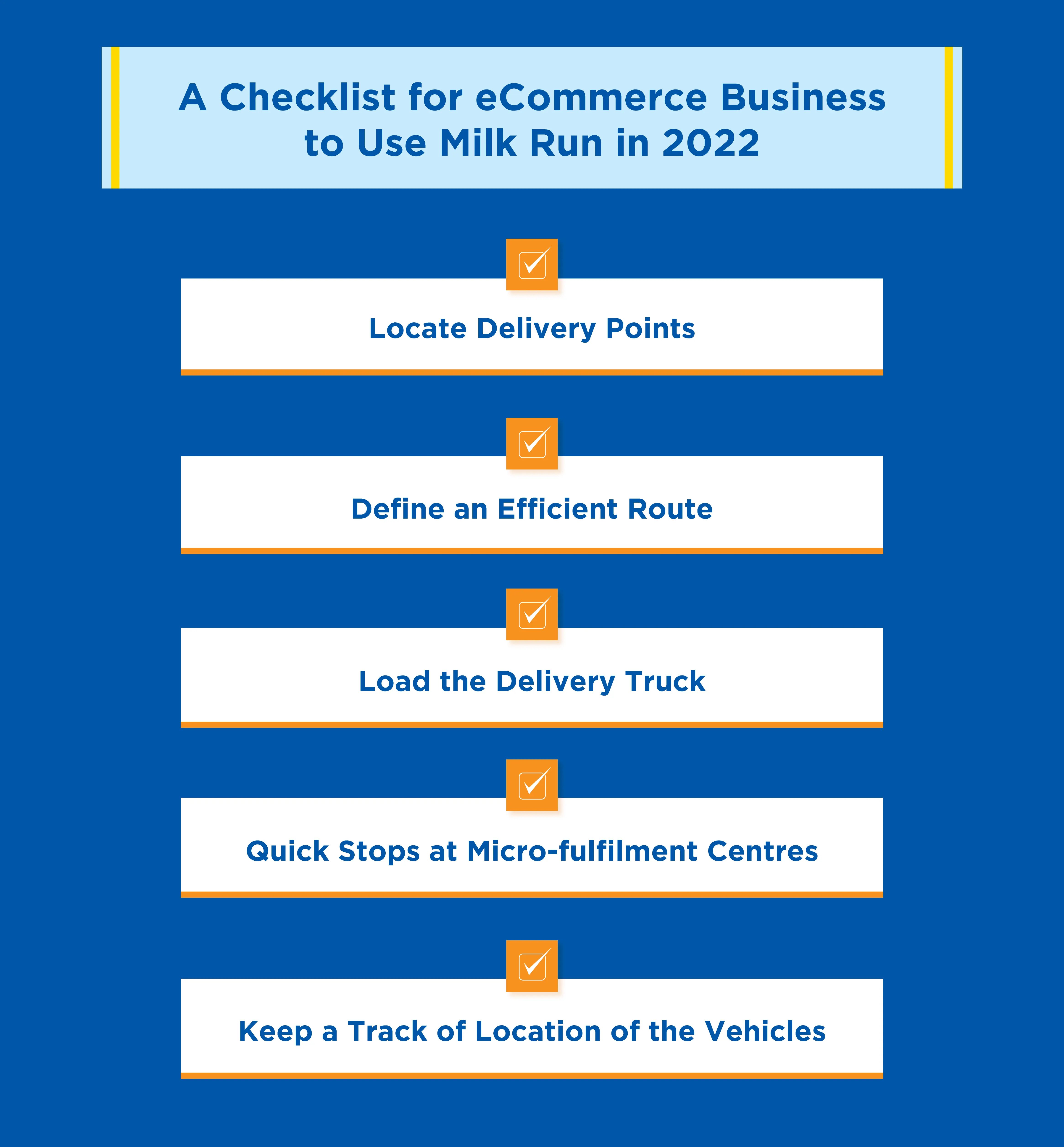
How Milk Run is Related to Lean Management Principles in Logistics
Being lean in the logistics industry simply means identifying and eliminating inefficient processes from the supply chain. The objective is to boost product flow and speed. Lean logistics focuses on streamlining processes at all levels and optimising the supply chain by eliminating waste, which is critical for supply chain control. This is accomplished through improved inventory and material management, as well as the elimination of redundant delivery processes.
Simply said, the Milk Run approach enables for more regular deliveries of materials and supplies to many assembly areas or sections of your business that require replenishment. Overstocking and the need to manually request more materials are often reduced as a result of this. It also keeps production operations moving across the shop floor, reducing downtime significantly. As a result, it is frequently used to optimise a supply chain.
Operators and material handlers follow predetermined standard delivery routes throughout the plant in the most common configuration. These supplies are most typically provided to regions of the facility that are always in need of resupply, which is usually found on the assembly line. These delivery routes are generally scheduled out during the shift to guarantee that the assemblers can continue to assemble per production schedules.
How to Hire People for Milk Run
We can define milk run as an efficient delivery process in the logistics industry. Therefore hiring people for a milk run entails a similar method to other logistics operations. An important part that you have to look out for is the reliability of the staff. You need to gauge the efficiency of the truck drivers and how they can navigate the longer routes without a hassle. You need to negotiate appropriately with the suppliers to coordinate during the loading and unloading procedures.
Alternatively, you can opt for 3PL or 4PL partners to take on the tasks for your eCommerce company. Choosing the perfect 3PL company consists of considering a plethora of criteria. You need to check if they have robust technologies and the capability to accommodate customization. In addition to that, you should check if they are compatible with your company's growth and scaling plans.
Should You Use Milk Run for Your Needs?
Milk run delivery is a great way to optimise the logistics of your company. You should consider using this method if your company manufactures goods and has a constant demand for raw materials. You can also consider this for eCommerce order fulfilment wherein you can complete more deliveries in a day by planning a master route.
Summing Up
For a Milk Run system to be fully effective, it must be part of larger lean process implementation. It only takes one milk run to prove that you're doing things correctly. It could take years of practice and tweaking to get to the point where you can say you're doing it efficiently. Many firms have successfully introduced milk run routes into their material handling operations with the help of a 3PL.
Frequently Asked Questions (FAQs)
What is a milk run?
A milk run is a logistics delivery approach that ensures that various deliveries from various vendors can be handled with optimal capacity utilisation and minimal expenditures. The name Milk Run comes from the method used by trucks to bring milk to dairy cooperatives on a regular basis, gathering up milk from numerous suppliers and delivering it to a central place for processing.
A milk run ensures that the shortest distance is travelled and the greatest amount of demand is transferred onto the truck or delivery vehicle, ensuring that demand is met while transportation costs are kept to a minimum. This is used when the load is dispersed throughout a large number of locations and smaller units. Carrying from each centre separately would be prohibitively expensive, so a system is devised to meet the needs, and all of the various units are acquired and transported accordingly.
How does milk run work?
The milk run usually works in the following manner:
- Develop a plan for the master route.
- The vehicle begins at the first centre point.
- At each supplier location, there is a loading dock.
- At each supplier point, if any, there is unloading.
- At the central point or destination, there is final unloading.
What does milk run mean in shipping?
The milk run process in shipping is critical because it promotes a system that results in lower costs and increased efficiency. Instead of delivering many deliveries to a single point of demand, a single delivery truck makes multiple runs to various locations and picks up the items. This ensures that costs are kept low and that one vehicle is fully utilised. It loops in a circular motion.
Who should do milk runs?
Milk run delivery can become an essential component of the logistics system for various manufacturing companies. eCommerce companies using 3PL delivery partners. It has become a fundamental idea in lean and agile businesses where cost-cutting is critical. It is closely associated with just-in-time delivery and ensures that materials are delivered at the most opportune periods. It entails material routing with various pick-up points and delivery to regions with high demand.
